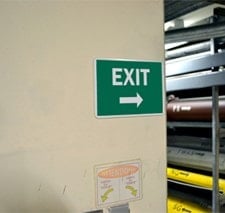Keep Exits Clear and Avoid Obstruction Violations

Anyone who has experienced the horrors of a fire can attest to its impact. If the fire alarm were to go off right now, where would you exit? Is there a clear path? Disasters of any kind rile emotions and affect people's actions, which is why planning and visual communication are essential.
Unsafe Intentions
In 2019, there were 1,291,500 fires and 3,704 resulting deaths in the United States, according to the National Fire Protection Association. The top causes were cooking, heating, careless activities, and electrical malfunction. Yet, secondary conditions-such as locked doors, lack of retardants, falling debris, and other hazards-are often what lead to deaths and injuries.
"Obstructed emergency exit access impedes employees' ability to exit swiftly in the event of a fire or other emergency, and unsafe storage of materials exposes employees to crushing and struck-by hazards. Employers are responsible for supplying their employees with safe and healthful workplaces," said OSHA official Galen Blanton in Boston, Massachusetts.
OSHA has specific requirements for emergency exit routes. Normally, emergency exit doors are locked from the outside so that no one can enter. On the inside, doors are to be unlocked with an alarm that will sound when someone opens them during business hours. That way, when others hear the alarm, they know to exit as well.
At one retail chain location on the East Coast, OSHA inspectors found the store's emergency exits were not only locked, but also blocked by miscellaneous items. They also found that these hazards were intentional and part of the store's protocol. This discovery outraged the inspectors, who issued the store a fine. Then, another location of the retail chain received a fine for the same violation. Followed by yet another store. In fact, OSHA reported that it issued over 300 citations for the same offenses across numerous U.S. locations.
"[Certain] stores have a history of not taking the safety of its workers and customers seriously," said OSHA official Danelle Jindra in Tampa, Florida. "Until appropriate precautions are taken to protect their employees from these well-known and frequent hazards, OSHA will continue to hold them accountable."
Correct Hazardous Conditions
 Employers are required to follow the law and comply with regulations that protect workers from injuries and fatalities. Safety should go beyond compliance, since best practices are known to improve a company's bottom line. Here are several tips to keep emergency exits safe, efficient, and compliant:
Employers are required to follow the law and comply with regulations that protect workers from injuries and fatalities. Safety should go beyond compliance, since best practices are known to improve a company's bottom line. Here are several tips to keep emergency exits safe, efficient, and compliant:
- Tidy up: Improve storage safety. Keep boxes, racks, forklifts, ladders, and other items away from the exit-even during construction or building alterations. Acquire additional storage if necessary. This is a great way to kick off a 5S plan or evaluate how to sustain a workplace lean management system. Mark areas for tools so that items have a place for easy access.
- Create a path: Designate visible lines for pedestrian and vehicle travel and indicate high-hazard areas. Identify adequate exits, rooms, and non-exit doors.
- Light the way: Low-light areas can become dimmer in emergencies. Implement emergency lighting and use bold or glow-in-the-dark markings for exits and paths.
- Inspect equipment: Make sure emergency equipment is available in working condition and is clearly visible to workers. Fire extinguishers should have regular inspections. Refresh fire-retardant materials periodically.
- Plan accordingly: Workplaces can easily update emergency action plans after thoroughly inspecting and documenting potential hazards using a job hazard analysis (JHA). Create a list of actionable items and work through them.
- Training: Besides training workers on what to do in an emergency, they also need to know how to keep work areas clean, how to stack boxes, where to find equipment such as fire extinguishers, and understand the importance of keeping emergency exits clear.
An effective way to keep workers alert to best practices and protocol is through signs, labels, and floor marking. Create boundary lines near exits to remind workers that items do not belong past that point. Use signage to mark alarms, doors, and other information. Use labels to identify the contents of containers and other items. Emergency exit safety priority is part of solid company culture and health and safety program. Reinforce safe work policies with thorough communication, training, and continuous improvement.
Related Resources

4 Wayfinding Errors and How to Fix Them
Employees should be able to find their way safely and efficiently around the workplace. When crucial signage ...
Read
Plan Ahead: Enhance Emergency Safety
Accidents will happen, and so can emergencies. As equipment and processes change, it's important to keep ...
Read
Floor Marking That Improves Fire Safety and Compliance
How Can Facilities Make Critical Areas Easier to Find in an Emergency? Can personnel and visitors easily ...
Read.png)





